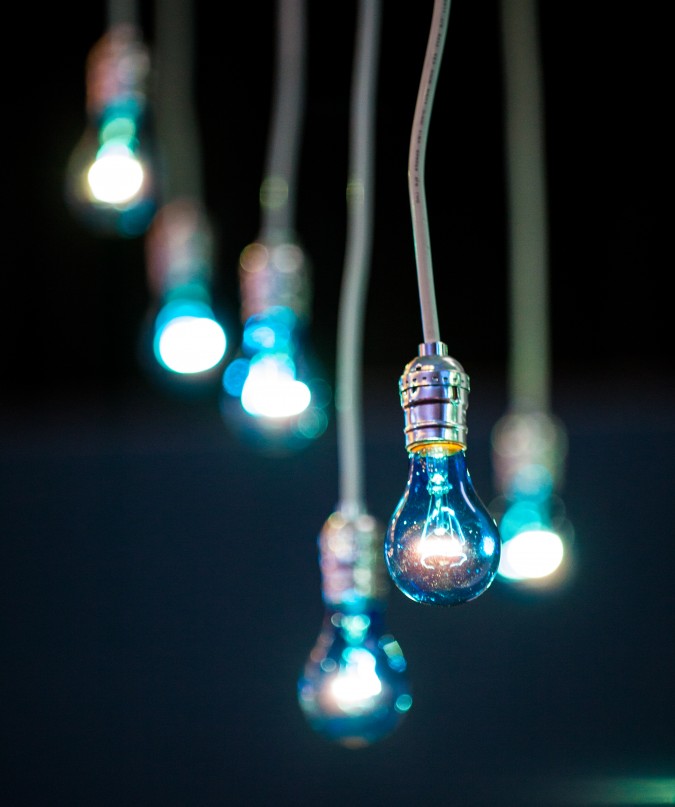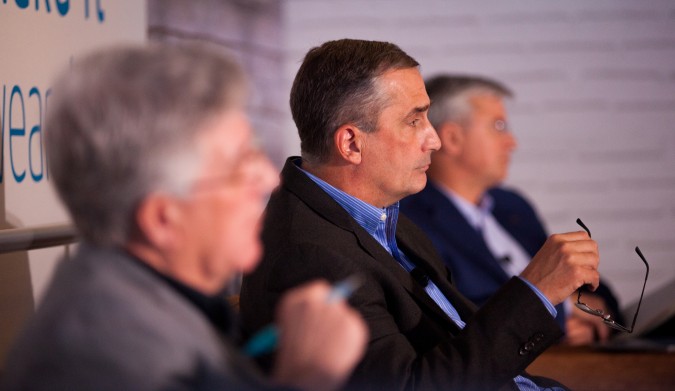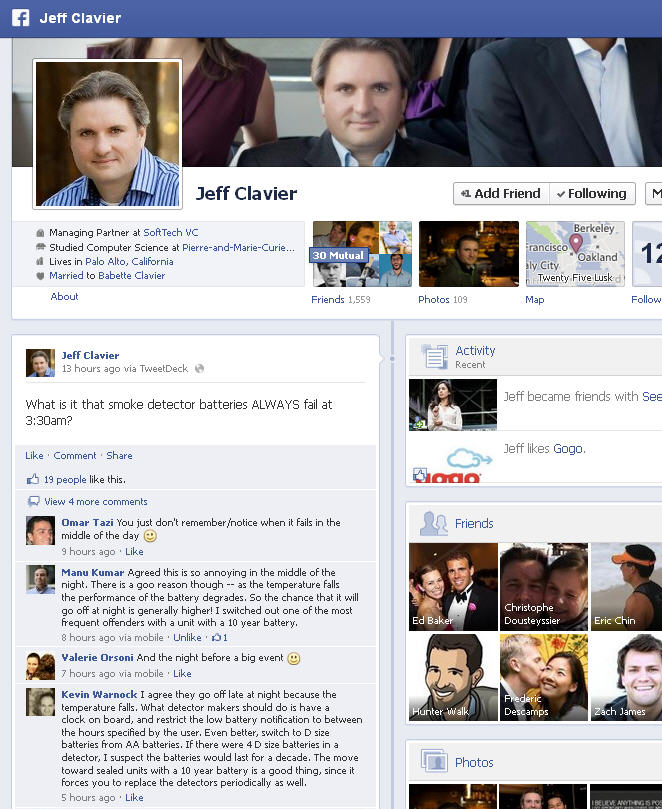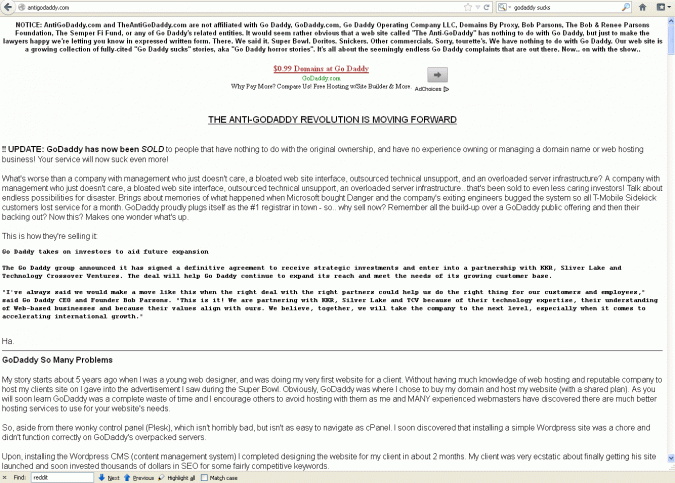Covid-19 dashboard website created by high school student
I learned about a Covid-19 dashboard website that updates the world on the Covid-19 virus once a minute, by scraping other websites around the world.
Here is the url: https://ncov2019.live/data
Here is an article about this dashboard, which was built by and is maintained by high school student Avi Schiffmann in the United States. He started it in December 2019, when there were only reported cases in China. Impressive foresight.
Covid 19 worries
Today is Tuesday, March 10, 2020. I have been staying at home for the last week or so to avoid contracting the Covid 19 virus. I have been reading the news, and have seen pictures of empty subway trains during San Francisco rush hour. I figured that would mean people would not be out shopping either. I was wrong. I went to Home Depot to return some items I don’t need, and the store seemed just as busy as any other Tuesday. Then I went to Target to get some hand soap. The store was perhaps a bit slower than normal, maybe 80% of normal. The store had no liquid hand soap for sale, and no hand sanitizer. Most of the bar soap was sold out too. Then I went to Safeway, and the store was just as busy as normal. They had two large bottles of liquid hand soap, but only two, and I bought them, as I am washing may hands so many times per day that I will go through these in the next two months.
I saw hundreds of people during this afternoon of shopping, and nobody had on a mask, and nobody was trying to keep a safe distance from anyone else that I could see. I never saw anyone change their walking path to stay six feet away from someone approaching.
I wore my N100 welding fume mask and rubber gloves, and changed my shoes when I got home and washed my hands for more than twenty seconds. I don’t understand the appeal of paper N95 masks, which currently sell for a fortune. I think non-disposable N100 masks with a rubber face seal should be the minimum people consider given the consequences. I know the current guidelines call for nobody other than health care workers to wear any mask, but I am suspicious this advice is due to an insufficient number of masks available, not that N95 or N100 masks convey no protection. I wore my mask for hours when I learned to weld, so I got used to it, and fortunately I bought a second mask back then, so I am now wearing a brand new mask that does not have any welding fume odor.
There are thirteen confirmed cases of Covid 19 in San Francisco, but almost nobody can get tested, so there are probably far more cases that are not yet diagnosed. I will happily wear my N100 mask when not at home for the foreseeable future. I worry San Francisco residents by the hundreds or even thousands will soon come down with Covid 19 illness, and that all this mask-free activity will prove to be deadly. Just yesterday Italy ‘locked down’ the entire country and suspended all debt payments, including mortgage payments. I can imagine San Francisco locked down by the end of this month or April, 2020 at the latest.
First annual Intel Make it Wearable competition November 2, 2014
On Sunday afternoon, November 2, 2014, I had the pleasure of attending the first annual Intel Make it Wearable to identify exciting technology companies making or proposing to make computers that one wears rather than carries or is stationary.
Make it Wearable is an ambitious new competition, and it’s the most polished and exciting competition I have attended. That’s saying something as I have attended dozens of competitions over the years.
The ten finalists come from China, Chile, the United Kingdom, Germany and the United States. The ideas were wonderfully diverse as you’ll soon learn which helped to keep the event lively and full of surprises. Sex appeal for business competitions is desirable because it helps attract the press and future competitors. I saw reporters from Yahoo and CNet at the event, and even reporters from the Middle East.
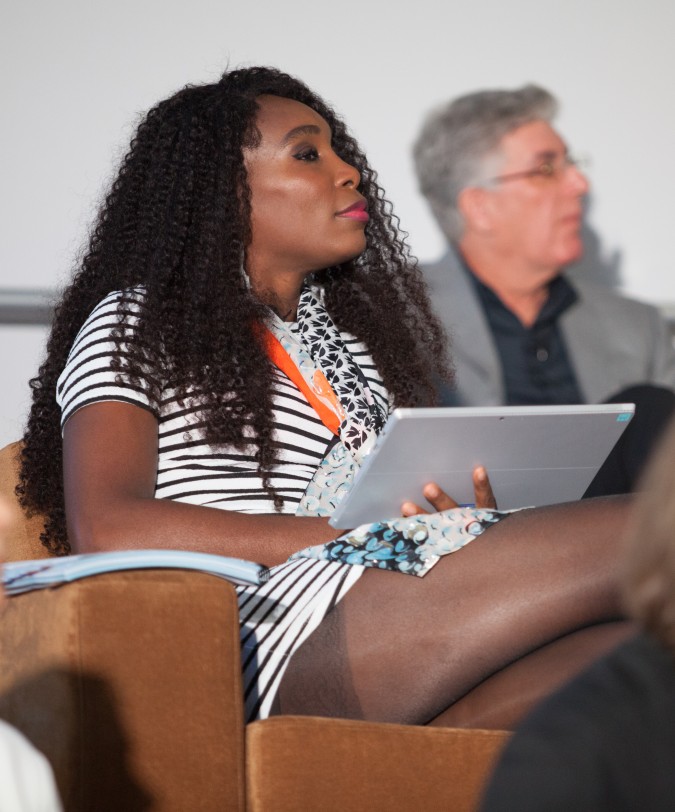
Venus Williams listening to a pitch as a judge for the 2014 Intel Make it Wearable competition on November 2, 2014. Note the Intel chip containing Microsoft Surface Pro tablet computer Williams is holding. The judges voted via these tablets.
Before I jump into the companies, allow me to talk about the event venue, the W Hotel across the street from the Moscone Convention Center in San Francisco, California USA. This was a great choice. The W is very fashionable. It’s not dull and boring like so many big hotels. Intel didn’t just go with a standard W event room though. A designer outfitted the rooms with custom wall textiles that resembled old barn wood and white painted bricks. This theme carried through to the custom printed name tags. There were light sculptures that featured dozens of clear globed incandescent light bulbs dimmed enough you could see the glowing filaments without squinting. These bulbs were dangling down on wires, and the idea was to reference the light bulb over the head to bring up the idea of a fresh new idea being thought up.
There was a disc jockey ever present in the two rooms, though one used her RFID embedded fake fingernails to manipulate a musical track by dipping her fingers in a shallow clear box of water. She got a lot of attention for this, and it was mesmerizing to watch. I learned this was her first gig playing music by playing with water.
The rooms were packed, and the crowd was surprisingly stylish and hip… far, far more hip than the crowds at the business competitions I have attended on college campuses. The only negative is that the event was not open to the public, a big change from previous Intel business competitions I have attended for years in Berkeley, California. I suspect the reason is that this first year was an experiment for Intel, and they wanted to test things out before widening the audience base. I was invited by Intel, a company that has been very kind to me over the years. My last Internet startup was an Intel Capital portfolio company.
My favorite company is Pro Glove, out of Germany. This team won third place and USD $100,000 in the competition.
Pro Glove makes solutions to improve the accuracy and speed of production factory workers. The company says there are 200 million such workers in the world.
The company sells gloves, sensors and software to process the data returned by the globe embedded sensors. Factories apparently for the first time can see exactly what workers are doing with their hands. If a worker skips a production step, the software can spot the mistake and flash a light on the glove to warn the worker to go back and complete the step. The glove analytics software can even tell where the worker is standing in the factory, so if they are walking around needlessly to fetch tools, the manager can spot that an perhaps move the tools closer to the worker to save walking time.
Pro Glove said that for BMW, each second saved on a repetitive task making a car translates into USD $7,500 per year savings for BMW, so having analytics about hand movements of production workers strikes me as a must have. Pro Glove cited various return on investment periods for their different use scenarios. Sometimes the system is predicted to pay for itself in a year, and sometimes in just there months.
I can see Pro Glove gloves being a must have in leading edge factories, and I can see room for lots of follow on products that will have high margin, particularly for the software designed to analyze the glove data. I think a large and enduring business can be built, and that is why I give this team my highest vote.
My second favorite team is Open Bionics, out of the United Kingdom. This team won second place in the competition.
Open Bionics proposes to make low cost three dimensionally printed bionic hands for children. The team proposes a price of just USD $2,000, which apparently is shockingly low compared to current bionic hands, which they said can cost up to $100,000 each.
The Open Bionic model is not as durable or as functional as the models costing 50 times more, but the low cost allows families to fit their handless children with a bionic hand multiple times as needed as they grow up. Apparently insurance won’t pay for a new $100,000 bionic hand each year for a growing child, so handless kids just grow up without handless until they stop growing and can get a fully featured metal bionic hand. Open Bionics was not specific about how current costly models are paid for and how often they are replaced, thus I am reading between the lines a bit here in this paragraph.
The Open Bionic team proposes to keep the cost low by not having patients meet with any medical professionals. Instead, the company will send an Apple iPad brand computer tablet with a 3D scanning attachment to the patient by postal mail. The customer will scan their own arm stump and return the iPad to the company. The company then prints out and assembles a hand that will fit the exact stump dimensions of the patient, and the hand will just show up at the customer’s home by common carrier, to be self installed by the customer.
The hands don’t have a wrist joint, but they can open and close by the wearer just thinking the same thoughts handed people think when they want to open or close their fist. There are electrode sensors that are taped to the forearm of the wearer, and the Open Bionic team had the electrodes on his own arm, and could make the bionic hand open and close just by his thoughts controlling his forearm muscles. It was an impressive demo.
I got to play with one of the bionic hands, and I could feel the hand squeezing my hand when activated by a push button ‘demo’ switch.
Open Bionics has the opportunity to dramatically improve the life of handless children. The price proposed frankly seems too low to keep the company afloat, so I worry about their viability. But the price can be adjusted, and since the team won USD $200,000 in this competition, they have some breathing room to figure out both their technology and the business.
My third favorite team is Nixie. This team won the grand prize in the competition — USD $500,000.
Nixie had the most eye popping video demonstration of their product.
Nixie proposes making a tiny drone helicopter that contains a still and video camera. The drone can fold up and wrap around a person’s wrist. With the flick of the wrist, the drone can be unfolded and then can start up and take flight away from the wearer. Once at a suitable elevation and distance, the camera can face the use and take a picture or start recording. Once done, the drone will fly back to the user and turn off.
Nixie sees itself as a competitor to Go Pro and similar action cameras. Eventually Nixie says they want to compete with normal point and shoot digital cameras.
I held a prototype Nixie drone in my hand, and it is cute. However, it looks impossibly fragile and totally unsuited to wearing while rock climbing, the stated first market Nixie envisions. I can see the drone simply falling off the wrist and falling on someones head below.
But I am happy Nixie won first place in this competition. The idea I think will wow many observers, and it will help brand the competition as one where really cool consumer products can be born and launched. That’s good for Intel and good for the competition.
But I think Nixie won by making the drone wearable as a way to be eligible to compete in this competition. In the absence of the competition, I think the product would have taken a different form. If I were rock climbing, I would want the drone in a protected case that I could easily open and access when the time was right for taking pictures.
Nixie is likely to be costly to start. I can see it costing USD $1,000 to early rock climbing adopters. I think they will find customers even at this price.
I don’t think there are strings attached to the Intel half million dollar prize, so I think that Nixie is welcome to ditch the wearable aspect in favor of practicality. I encourage them to go that route, even though it may secretly irritate Intel.
I admire Nixie for getting a non dilutive $500K to pursue their photography drone. This kind of thinking is the hallmark of successful entrepreneurs — tailoring an offering for the market at hand. Intel was the customer, and Nixie gave Intel a product it asked for. And Intel will be proud of Nixie even if they just become a successful photography drone company.
I can also imagine ways to make a Nixie both wearable and very unlikely to get damaged during arduous climbing. Just put it into a head mounted hard case inside a custom helmet. When the time comes, the helmet wearer could command the helmet to open and for the drone to take off from there. This could even be voice activated via a helmet mounted microphone.
Sadly, I don’t have time right now to finish this post. My grandmother is turning 103 years old December 12, 2014, and I have a project I have to finish by then as I promised her I would take it to show her. I have already spent three days on this Make it Wearable competition, and I need to get back to my regular life. I have a lot more pictures to post, and I want to tell you about the seven other companies, which also are very interesting.
12 years after 9/11/2001
I am dismayed with how the United States responded to four plane crashes 12 years ago this day, September 11, 2013.
Wars were started that still continue. Trillions of US dollars have been wasted destroying much more than just property and life.
How much better would the world be if President George W. Bush treated the September 11, 2001 events as regular police matters.
Osama bin Laden still could have been found and brought to trial to determine his guilt or innocence, and we wouldn’t have wrecked our good will like we have with these needless and counter productive wars that are a drain on the world. Constant war is a drain on the mental energy of everyone in the world, I fear.
President Bill Clinton handled the 1993 World Trade Center truck bombing as a police matter, and I recall that some of the perpetrators were located, tried in civilian courts, convicted and punished. That’s the way to handle both daily criminal and infrequent catastrophic criminal events.
I believe the people behind the 9/11/01 attacks were upset with how the United States conducts itself on the world stage. I think a sane and proper response would have been to admit to the world that the United States does overstep its place more than it cares to admit. We should have attempted to open a rich and ongoing dialog with those who attacked us to solicit their advice on how the United States could tone things down in the future so that others wouldn’t be so hopping mad that they attack us.
Would such a polite and measured response have worked? I don’t know. But I think it would have cost less in every measure.
If a prestigious entity with world visibility were created where we would yearly sit with our attackers and those who think of attacking, we would have taken the wind out of the sails of our attackers to a substantial degree. The entity would need to have power, prestige and money for it to be seen as more than window dressing by those who might attack us. It would need to make sure action was taken after meetings so all those watching would know their voice was being heard and acted upon. This would be one heck of an organization, and I don’t know how to pull it off, but it needs to be built. We know how to build huge, costly organizations that can cause action. The US military is one such huge costly organization, for example. The organization for good I propose might need to rival the US military in size, scope, power and budget. That might sound crazy, but what really are we getting for our military expenditures now? I would argue a lot less than nothing. We are building negative equity like at no time in the history of the United States. We could fund the organization I propose by reallocating half the budget of the US military as a start. With just half its budget intact, the United States would still have a huge military, but we would also immediately have the largest organization for world change on the planet, and just by having made that commitment, I predict more than half our ‘need’ for a military at all would evaporate. Half of our military is still a lot, and think of the new friends we would make with the new organization for change I propose. Far fewer people would wish us harm if we were doing good on such an intense global scale.
Now prepare yourself for the most provocative text I’ve written in my life…
Soon after the September 11, 2001 plane crashes, United States of America President George W. Bush should have said something like this:
“The United States is profoundly sorry and embarrassed.
Without an invitation, the United States has been acting like the policeman of the world.
We recognize that there are other valid points of view on how to live life. We don’t want to be attacked like this again, so I ask those of you who wish us harm to please share with us how we can avoid such attacks. We are willing to make big changes, and we’re willing to spend a lot of money to be a nicer world citizen. To demonstrate our resolve to change and see the point of view of others, the United States today is contributing USD $100,000,000,000 to get the ball rolling towards a more fair and sane planet. We will spend to improve the lot of the people that attacked us.
On behalf of the United States of America, I am sorry that this country has acted such that you believe you had to attack it. While this country may not agree with your points of view, it does recognize that you view your points of view as valid and worth advancing. Clearly, we need to talk, and we will talk. I personally will talk face to face with your representatives.
The United States feels so strongly that it will learn to play nice on the world stage that beyond the USD $100 billion I just spoke of, I am committed to working with the US House and Senate to gain approval to spend up to USD $3,000,000,000,000 over the next decade to fix what’s wrong with the world.
The United States is not a vindictive nation.
The United States could respond by starting wars and destroying entire countries, but we’re bigger than that, and we will show our attackers that the people of the United States are your friends, not your enemies. War is terrible. Peace is golden. The United States stands for peace, not war.
On behalf of everyone in the United States, including the families of those who lost loved ones today, I appologize for our actions, attitudes and positions that led others to believe that they had to attack the United States so violently to get our attention.
With hard work and determination, today will be the last time that any people of the world should feel that they have to attack us to get us to change our overstepping ways.
The United States in fact is ashamed that it has come to this, that we have upset other people so dramatically and profoundly that they have responded by flying airplanes into our landmarks, ending the lives of so many earnest people in the process.
Let us spend the following ten minutes in silence to reflect on the enormity of the events of today. Let us imagine a world filled with peace, happiness and enough to eat and drink. Let us cast aside our revengeful impulses so that we can come together at a meeting table to plan how the people of the world shall overcome the horror of today in favor of the brightness of a more promising future for all of humanity.
To the friends and family of those who lost their lives today, if you want to be upset with somebody, be upset with me and the past Presidents of The United States of America. What happened today was a reaction to this country overstepping its place in the world. It simply is not nice to tell other people how to live while we consume such a disproportionate percentage of the resources of the planet. In the decades ahead, we will need to learn to share our bounty with others more than we have done so far. Look on this redistribution of wealth as your insurance payment for the future safety of you, your property and your loved ones, not as a handout. The United States has been acting like a rich, spoiled kid on the playground eating the finest candy and laughing while others nearby starve and have little. We can remain a wealthy and prosperous and happy nation while at the same time leveling the playing field. We are a nation of thoughtful and ingenious innovators, and if we put forth our full effort, perhaps 100 times greater than what was required to place a man on the moon, we can solve the really big problems the world today faces.
Three trillion dollars is a lot of money. We can spend that amount building peace, love and goodwill. We can also spend three trillion dollars killing hundreds of thousands of people and destroying countries.
I am certain that three trillion dollars of peace, love and goodwill is more valuable than three trillion dollars of rubble, hate and death.
May September 11, 2001 be viewed by history as the first day of the most kind and peaceful period the world has yet known.
For those of you that worship a higher power, may that higher power give you comfort on this historic day of new beginnings. Let us rejoice in the saved lives of the hundreds of thousands of people this nation will not kill in response to the events of today. Let us rejoice in the new lives of the hundreds of thousands of babies by coincidence born this historic day. It is tragic that the United States lost thousands of its residents today, but keep in mind more babies were born in the United States today than lives were lost in these four plane crashes.
The United States is your friend, not your enemy. The United States wants peace, prosperity and fairness for all the people of the world.
Tomorrow will be better.
I love you.”
Instead, President Bush said something genuinely and dramatically stupid:
“You’re either with us or you’re with the terrorists.”
This is such an unwise thing to say it sounds like something out of the mouth of a high school student at a third rate institution. Yet his short statement formed the basis for spending of even more trillions of dollars than I proposed the United States spend in my mock speech above.
The United States ruined itself by its unwise response to four plane crashes.
I don’t spend a lot of time delving into the deep details of world politics. I am not a historian. I am not particularly well informed about what I write about here. I admire Noam Chomsky and Dennis Kucinich. I think Chomsky and Kucinich would like what I have written here today. I hope to meet both men one day, perhaps in response to this post if I am really lucky.
I believe I possess a very fine and properly working moral compass. I am proud of and guard my moral compass. I’ve made profound and life altering changes in my life when needed to protect and guard and respect my moral compass, even when it would have been so easy for many others to compromise. Perhaps the above makes me look childish and unrealistic. Perhaps I will lose a friend or three by what I’ve written. But what I’ve written has been on my mind for ten years now, and today I decided to just say what I first thought starting about 2 seconds after I first heard about the first plane striking one of the towers of the World Trade Center complex in New York City, New York, USA.
The United States has ruined itself by its response to four plane crashes.
Why?
PS – I am sorry for the loss of the family and friends of those who lost their lives in the events of and following September 11, 2001. By writing this post, I do not intend to upset anyone who lost a loved one. My heart also goes out to friends and family of those who have been killed or injured in the response to the events of 9/11, including those serving in military forces on all sides. I love the United States, and I love people generally, from all countries. I am so sad that all this death and suffering and hate has happened. It’s all so unnecessary and wasteful. Thank you for reading. I love you.
Kevin Laurence Warnock
San Francisco, California USA September 11, 2012
Note: I published this post on September 11, 2011, the 10th anniversary of the 9/11 attacks.
Today, September 11, 2013, I published this post again, changing the first sentence from “I am dismayed with how the United States responded to four plane crashes 10 years ago this day” to “I am dismayed with how the United States responded to four plane crashes 12 years ago this day, September 11, 2013.”
I am proud of this post, and I plan to republish it annually on September 11th.
ShoppinPal.com smart phone app from Fermyon, Inc. improves the brick and mortar retail shopping experience for both buyers and sellers
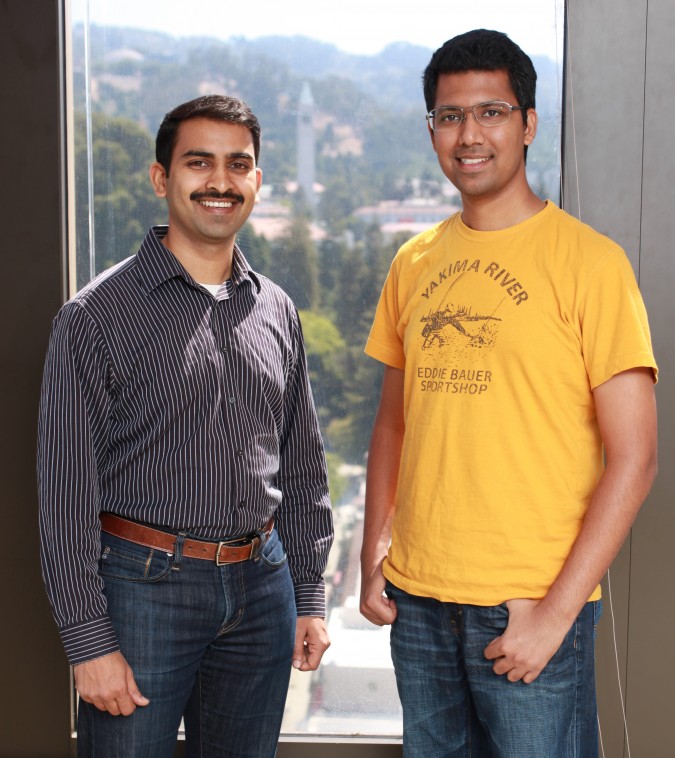
Cofounders of ShoppinPal.com - Sriram Subramanian, CEO, and Pulkit Singhal, CTO. July 26, 2013. Photograph taken at University of California Berkeley Skydeck accelerator, on the top floor of the tallest building in Berkeley, California. That clock tower in the background is on the UC Berkeley campus. Photo by Kevin Warnock.
Fermyon, Inc. is the company behind the impressive ShoppinPal smart phone application that improves the retail brick and mortar retail shopping experience for both buyers and sellers.
On Friday, July 26, 2013, I met with Sriram Subramanian, Chief Executive Officer, 34, and Pulkit Singhal, Chief Technical Officer, 29, the co-founders of Fermyon.
Retailers complain about people treating their physical stores as free showrooms for consumers to touch and evaluate items they will then actually buy online, frequently from giant Amazon. The retailer I suspect feels cheated by these people since they received something valuable, but didn’t make a purchase from the store to compensate the store for their efforts.
Consumers like mobile shopping apps like the one Amazon gives its customers. Smart phone shopping apps let people look up specifications and customer reviews to help them make smarter purchasing decisions. I don’t see shopping apps disappearing, since they offer such compelling value to consumers.
Retailers with physical stores could of course create their own smart phone applications that mimic those from huge online merchants, but it’s mostly larger chain stores that do, because writing a shopping application is difficult and costly.
That’s where ShoppinPal comes in.
ShoppinPal is a service that retailers pay money for — 3% of sales for retailers with over USD $5,000 in monthly ShoppinPal sales, or $49.00 + 3% of sales for retailers that sell less than $5,000 a month through ShoppinPal. This strikes me as assertive pricing, but if it works, Fermyon will be in a position arguably even better than Visa and Mastercard, because Fermyon is not taking any fraud or refusal to pay risk that I can see. On the other hand, no small retailer could hope to deploy a system like ShoppinPal by developing the system itself, and showrooming is a looming problem that likely is motivating retailers to take defensive action.
Shoppers use the service for free.
The retailer gets access to a custom branded application its customers can install on their own phones. In addition, the retailer gets access to an online management console that shows what customers are buying, among many other statistics. Since buyers provide their email address when they install the smart phone app, the store can easily send them custom messages.
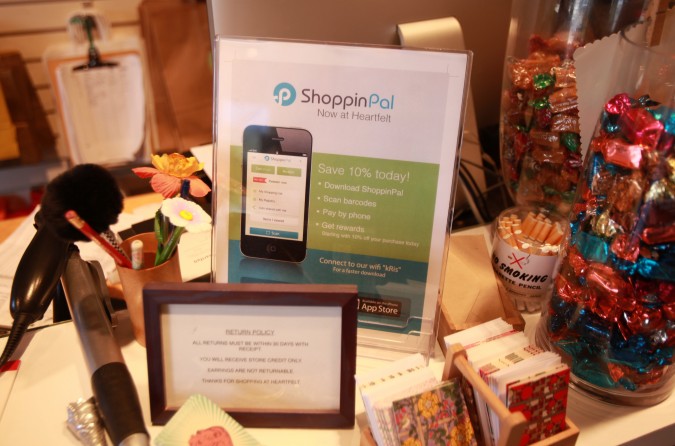
ShoppinPal app display at Heartfelt gift store at 436 Cortland Avenue, San Francisco, California, USA, August 1, 2013. Photo by Kevin Warnock.
For example, if a potential buyer uses the smart phone app to add several items to their ‘wish list’ the store will know about that and can gently remind the potential buyer to return to the store to buy the items. Buyers can be especially enticed to return by being sent discount codes that buyers can use to receive the items at a lower price. Buyers can even opt to have the items delivered to them, offering the convenience of online shopping to the offline world.
I like ShoppinPal. The small team of two co-founders and three staff have put together an offering that appears to come from a larger entity that has raised far more than the modest USD $120,000 in outside capital that Fermyon has taken in.
Buyer engagement potentially starts moments after walking through the door of a shop. One can ‘check in’ to the ShoppinPal app, like one ‘checks in’ on Facebook. The check in alerts store management that the buyer was present.
Next the customer can use the camera on their smart phone to scan the bar code on items they are interested in. The app recognizes the bar code and pulls up that product. The app can, at the option of the retailer, show customers recommendations for other items they may like in their store.
For new retailers, the ShoppinPal cloud based software taps into the retailers’ point of sale cash register system and reviews the receipts for the prior six months of sales. The software sees that people purchased certain items during the same transaction, and uses that set data to recommend that future purchasers also consider such grouped purchases.
CTO Singhal asked current retailers using their system to try the recommendation engine, and those queried marveled at how the recommendations matched with their memory of what many past customers had bought together.
The ShoppinPal app and the website are both beautiful – spare, elegant and clean. The management console is by Mixpanel, a separate company ShoppinPal pays to provide that service.
Sellers can add various incentives for shoppers to buy more items. For example, a discount can be applied after a certain number of purchases. Thus, a coffee shop could automate the ‘buy 10, get 1 free’ paper punch card that still is in use, and was in use at the tea shop where I met with Singhal and Subramanian.
That tea shop in fact allowed customers to store their paper cards in a physical file system on the counter out for the public to access. I marveled the tea shop would put such sensitive information out on public display, because a competitor could surreptitiously copy down a list of the shop’s best and most loyal customers. With quality video cameras in every smart phone, someone could just pretend they were looking for their card while capturing video of every card the thief perused. An electronic loyalty system like that included in ShoppinPal reduces the risk a customer list can fall into the hands of an outsider or an employee that should not have that information.
Inside ShoppinPal, there is not only a wish list, but a gift registry, which should encourage others to buy at a retailer the others may not even be aware of when the items are added to the registry.
ShoppinPal communicates via application programming interfaces to two point of sale cash register systems — Lightspeed Retail and Vend. ShoppinPal hands off to the cash register the precision task of calculating sales tax, sidestepping a thorny problem, since there are thousands of sales tax jurisdictions.
As a customer walks around a store, as they pick up items and place them in their physical shopping cart or basket, they can click ‘add to cart’ within the mobile app. This gives a running total of their planned purchases, and when the customer is ready to pay, they can buy directly from the app, which will display a receipt on screen the customer can show to store staff as they pass through the exit.
This pay within the app feature over time will let retailers hire fewer checkout clerks. The pay within the app feature can be turned off by the retailer that prefers customers visit a cash register to physically run their credit cards through a credit card terminal.
Whether the purchase is paid for in app or at a retailer’s register, the ShoppinPal management console keeps track of all the buyers’ purchases, and makes the purchase history available to the customer, which in my mind is a great perk for the customer. When I shop at Lowes and HomeDepot, I use their loyalty cards mostly because their systems email me a copy of my receipt within minutes after a purchase, which makes my life easier at income tax time.
The sexiest feature of the mobile app is a feature that adds fun to getting a discount. Instead of just writing out ‘you get a discount’ the app presents a silvery gray patch that looks just like the silvery patches covering the digits on lottery tickets. You have to ‘scratch off’ the patch with your finger, and as you rub the screen with your finger, the silvery ‘material’ under your finger vanishes. The effect was startlingly captivating such that I believe a tiny company could be formed just to advance this feature inside other unrelated products from other companies.
ShoppinPal is still an early stage venture. The company was incorporated in January, 2011, but work didn’t really accelerate until CEO Subramanian completed his MBA in June, 2012, last year.
Fermyon has signed up four customers, all via resellers that have agreed to carry their product. I view it as a positive sign that resellers are promoting their product while the company is still so young, for resellers have to be particularly careful to not damage their reputations.
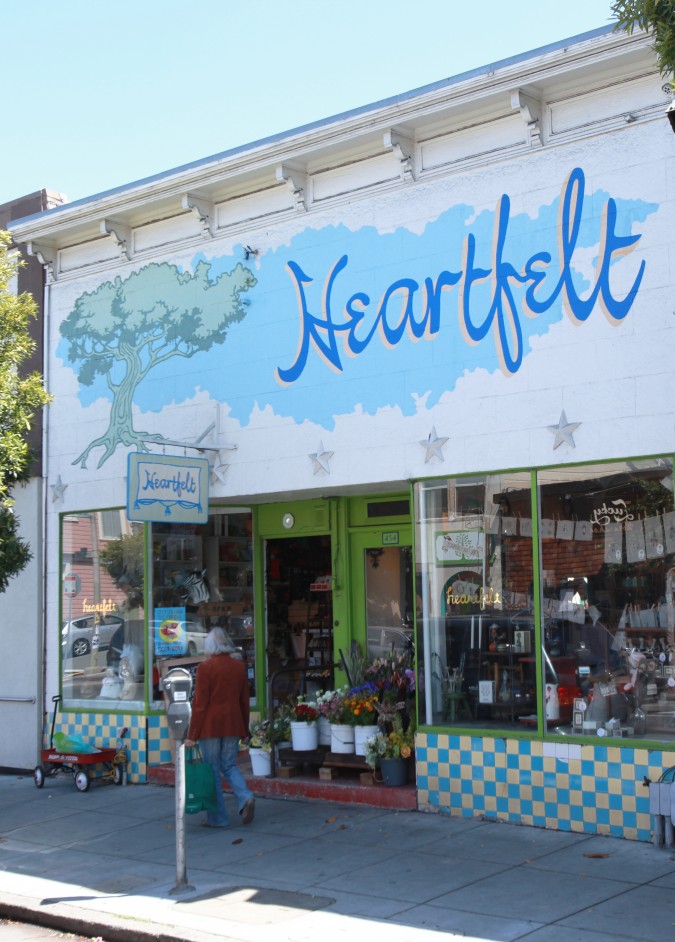
Exterior of Heartfelt gift store at 436 Cortland Avenue, San Francisco, California, USA, August 1, 2013. Photo by Kevin Warnock.
ShoppinPal’s customers are Harney & Sons in New York City, Heartfelt in San Francisco, Isha USA in Tennessee and Marthas Vineyard Glassworks in Massachussets, all in the United States. The Isha implementation is the most demanding, because the organization runs events that draw about 1,000 people twenty times or so per year, so the transaction volumes spike tremendously during events and subside the rest of the year.

Interior of Heartfelt gift store at 436 Cortland Avenue, San Francisco, California, USA, August 1, 2013. Photo by Kevin Warnock.
I live in San Francisco, so I decided to install the ShoppinPal app on my Apple iPhone 5 and visit Fermyon’s customer Heartfelt, a charming and totally adorable gift shop in the Bernal Heights neighborhood. This single store business doesn’t sell items that people are likely to evaluate and then order online from a giant website. But the Heartfelt is the kind of place that I think could benefit from the loyalty, gift registry and wish list features in ShoppinPal. The store also I suspect prides itself on having just the right gift, as there appear to be over 10,000 different items for sale inside this small store. As I was browsing around, I found half a dozen items I wanted to buy, and I am not even looking for gifts right now.
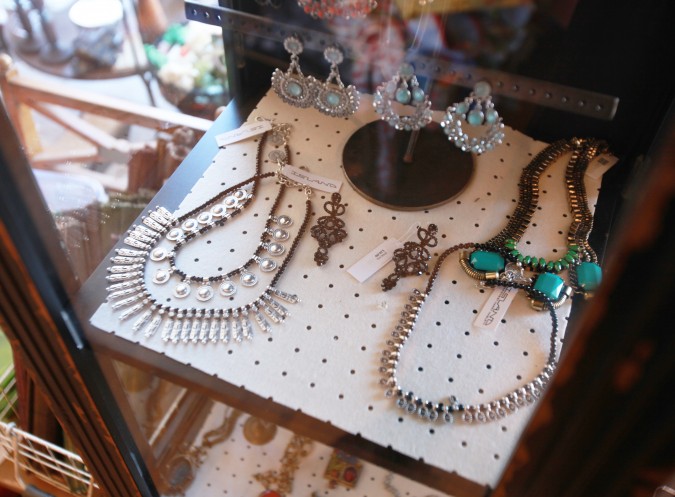
Jewelry for sale at Heartfelt gift store at 436 Cortland Avenue, San Francisco, California, USA, August 1, 2013. Photo by Kevin Warnock.
As soon as you check in, a horizontal red line starts sweeping up and down the phone display. The indicates the phone is looking for a bar code to recognize. I created a video of the ShoppinPal experience from checking in to just before payment. I have embedded the video into this post. The video is a bit shaky because I had to hold my large camera in one hand, and operate the app with my other hand, and since the phone was so close, the depth of field was shallow. But the video does show faithfully what the app does.
As soon as the app finds a bar code, it goes into search mode where it’s communicating with the cash register computer to find the item. This takes about two to six seconds. Then the item shows up in your shopping cart. From there it is confusing what to do next, since there is no ‘checkout’ or ‘buy now’ button. Instead, to continue shopping, you are to press the button in the upper left labeled ‘heartfelt,’ the name of the store. This should be labeled ‘back’ or ‘continue shopping.’ There is a button in the upper right called ‘cart.’ I didn’t try that button, but I assume that button takes you to the shopping cart from where one can checkout.
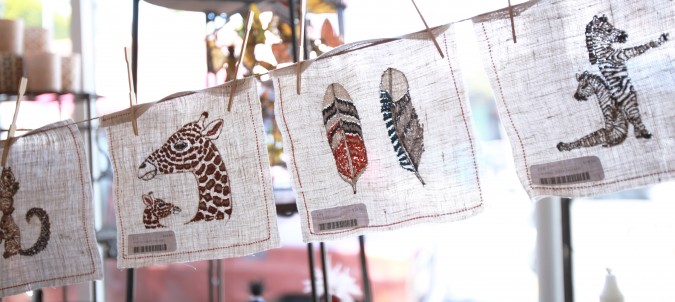
Textiles for sale at Heartfelt gift store at 436 Cortland Avenue, San Francisco, California, USA, August 1, 2013. Photo by Kevin Warnock.
I scratched off the panel as invited, and I got a 10% discount. I was given the chance to pay via credit card or PayPal, the payment service from auction giant EBay. I bought a lightweight wallet made from Tyvek, and I paid via PayPal. The process was quick and efficient, but my receipt listed my discount as $0.00 even though the 10% discount had been correctly applied to the total. I understand that ShoppinPal was only recently installed at Heartfelt, so I expect there to be small glitches to be worked out. For such an early stage yet ambitious application, ShoppinPal performed well.
As you might imagine, ShoppinPal has big dreams and has had sales meetings with huge brands that are household names throughout the US. I suspect that after they build their credibility with smaller retailers for the following months that they will land a national retailer.
ShoppinPal participated in 2012 in the Silicon Valley Bank Seed Showcase, a pitch event to investors for Silicon Valley Bank clients. Silicon Valley Bank is widely considered one of the most important banks in Silicon Valley for startups that aspire to or have raised venture capital investment. You can watch CEO Subramanian pitch on stage and then watch him later that day be interviewed by Carrie Walsh, Managing Director II, ESG, Silicon Valley Bank.
I could find no direct competitors to Fermyon.
The closest offering appears to be CardFree, which automates via a smart phone app some of the tasks that ShoppinPal automates, like payment and loyalty. But CardFree omits the ability to scan the barcode of products to bring up specifications and Amazon.com like product recommendations, two of the most compelling features of ShoppinPal, in my mind.
Another company that does part of what ShoppinPal does is CardStar from Constant Contact. CardStar appears to be a smart phone app just for storing and using loyalty cards from multiple retailers, so your physical wallet doesn’t burst from storing too many physical cards, like mine is threatening to do.
Another loyalty card company is BellyCard, which appears to be similar to CardStar.
Finally, there is a smart phone payment app called AisleBuyer, which lets in store purchasers pay via their smart phone. This company was acquired by Intuit in 2012.
See what former CNET Editor at Large Rafe Neeleman had to say about ShoppinPal in 2012.
The company’s name Fermyon is a play on the particle physics term Fermion. The definition of the Fermion is better left to the article on Wikipedia I just referenced.
I took the picture of Subramanian and Singhal that accompanies this post with my Canon 5D Mark II camera, my Canon 50mm f:2.5 macro lens and my Paul C. Buff Einstein studio flash unit.
The location of the photograph is the Skydeck accelerator run by University of California Berkeley. Jeff Burton is the Executive Director of Skydeck, and Burton encourages me to write about the UC Berkeley affiliated companies that the accelerator houses in its exceptionally glorious 10,000+ square feet of penthouse office space. If you look out the window in the center of the picture, you will see the clock tower that serves as the focal point of the UC Berkeley campus. ShoppinPal is headquartered at Skydeck, but this is not an indicator that the team is reckless with its finances. To the contrary, it’s an indicator that the team is careful with its money since the company’s office space is provided for free by the University of California, from where Subramanian earned his Masters of Business Administration graduate degree. Skydeck gives free office space to only the companies it deems most likely to succeed.
I became aware of Subramanian over the last year because we both attend monthly Cal Founders meetings, which are designed to help founders and mentors be more successful in business. Subramanian and I are more acquaintances than friends since we’ve only met and spoken a handful of times. He learned of this blog and asked if I would write about his venture, and I agreed because I had become intrigued when he had introduced his company during the roundtable discussions at Cal Founders meetings. I disclose the circumstances of how we met to deflect any appearance of bias due to my already knowing Subramanian.
Motorized vehicles should contain factory installed carbon monoxide and smoke detectors
All motorized vehicles, including cars, boats, ships, trucks, buses, planes and trains should come equipped from the factory with integrated carbon monoxide and smoke detectors.
Vehicles should contain carbon monoxide and smoke detectors because power trains can fail and sometimes deliver deadly carbon monoxide into the passenger compartment, killing everyone inside. This happened yesterday, April 1, 2013, when three men got stuck in some mud while driving their sports utility vehicle in the early morning dark. One of the passengers, Shain Gandee, was famous for his starring role in the Music Television reality show Buckwild. The coroner ruled the deaths accidental and declared carbon monoxide poisoning to be the cause of death. The mud reportedly covered the muffler of the truck. That may have forced exhaust through holes in the exhaust system underneath the passenger area, and perhaps some of that exhaust infiltrated into the cabin. The truck was an old model that looks like it’s had a rough life.
It was probably cold and dark out, and I can see the three wanting to stay inside with the motor running to stay warm until daylight. Had there been a carbon monoxide detector on board, the three would have been warned of the danger they were in, and could have shut off the engine and stepped outside for some fresh air. Better to be cold than dead.
Even electric vehicles should have smoke and carbon monoxide detectors, since batteries also are dangerous. Additionally, people might use propane heaters inside, and they emit carbon monoxide that can kill you when they are malfunctioning.
Detectors should be hard wired to the vehicle start battery, but should have 10 year on board battery backup as well, like all detectors should. Detector design should be standardized so a detector from a Rolls Royce Phantom will fit a Chevrolet Aveo, and vice versa. That way the cost to replace detectors at the end of their life will be low enough that people will be inclined to do so. There should be an interlock so the car won’t drive past 55 miles per hour unless a working and non expired detector is installed. This will more than gently nudge owners to replace expired or defective detectors. A red light on the dash is not sufficient reminder. Making the car not start is too extreme, since a user might be in danger if they got stranded. A speed limit is a powerful incentive.
A detector like I propose here should cost about USD $10.00 in quantity with the standardization I propose. I am sure Gandee’s family would have loved for him to have had a detector.
In the meantime, before my idea gets implemented on a universal scale, go buy a home style smoke and carbon monoxide detector and install it in your vehicle. If it goes off and saves your life, please tell me so in a comment so I know that people are reading this and acting upon my advice.
I don’t know how many unintentional carbon monoxide poisonings inside vehicles occur each year, but the number must be in the hundreds worldwide. An extra $10 to avoid these deaths is worth it.
Smoke, fire and carbon monoxide detectors should chirp to signal low battery condition only during waking hours – here is how
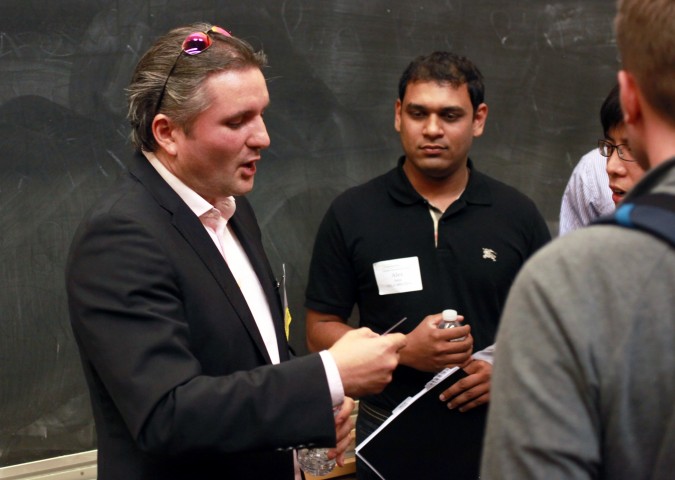
Jeff Clavier, left, August 30, 2012, at Berkeley Entrepreneurs Forum at University of California Berkeley
I have learned that smoke and fire detectors almost always signal low battery condition in the early morning between midnight and five o’clock. This wakes me up and forces me to replace batteries when I am sleepy. I suspect many people don’t have spare batteries always on hand like I do, and simply take the batteries out until they can go to the store. This leaves the premises less well protected, and I suspect fires have started during this period and that people have died.
The fix is so simple I can’t believe I only thought of it today.
Simply include a clock in all battery operated smoke, fire and carbon monoxide detectors. Have this clock powered by its own battery that can last a decade or more. Set this clock at the factory for the part of the world where the detectors will be sold. The low battery circuitry should consult this on board clock, and should suppress the chirping ‘low battery’ notification during typical sleeping hours, say from 10pm to 8am. The chirping can resume at 8am each day until the batteries are replaced. Alarms typically will chirp for months before they run out of power entirely, so the delay in chirping during the night will not cause a significant safety issue.
The clock should be user resettable so the detector can be moved between time zones by the buyer, or set to accommodate unusual sleep schedules.
I suspect the clock I am proposing costs no more than USD $.50 in bulk, and the feature that it will enable can be promoted to boost sales. I suspect such a detector will sell well because I suspect everyone with a detector has been awakened by their chirping.
Chirping during waking hours is likely to be a measurable advance in fire and poisoning safety, since awake and alert people are less likely to make mistakes, like removing the batteries or putting in replacement batteries backwards.
While the circuit designers are at it, they should program the detectors to keep track of the passing years and notify the user when the detector has reached its end of life, around ten years after manufacture. I am sure there are millions of ‘expired’ detectors still in use because people forget when to replace them.
This is my second post on how to improve detectors. My first post Smoke detectors should send activation warnings via text messages via Wi-Fi I wrote July 23, 2011.
I believe detectors chirp now early in the morning because batteries deliver less power when cold, and in many homes the temperature drops lowest early in the morning. Here’s a post by The San Diego Real Estate Inspection Company that agrees with me.
Thank you to SoftTech VC venture capitalist Jeff Clavier for sparking my imagination today to think up this fix. Clavier asked on Facebook this morning why detectors report low batteries exclusively at 3:30am. It’s then that I thought of including an internal clock to solve the problem. I posted my suggestion in a comment on Clavier’s Facebook Wall, and then decided to write this post to formalize my suggestion, with the hope the idea gets discovered and implemented.
If this idea makes money for you or your company, please send me an industry average royalty for using this, out of the goodness of your heart. I am guessing that will amount to about USD $.05 per detector, but that could result in my getting ever more wealthy over time given every residence on Earth should have multiple detectors forever. Thank you!
I will not patent this so it’s now in the public domain if it hasn’t already been patented, which is not unlikely given how simple the idea is. I could quickly find no mention of this idea after performing a Google search for this idea.
I wrote about Jeff Clavier last year, and I took the picture of him that accompanies this post. Clavier speaks colorfully. My favorite quote from when I saw him speak August 30, 2012?
“I passed on airbnb that some showed me when it was called air bed and breakfast and I said ‘air bed and breakfast… are you f—ing kidding me?”
My preference is that the world move quickly towards hard wired sealed detectors that have backup batteries that will last ten years. It also seems that non hard wired detectors should have solar cells like calculators and watches, to keep the batteries from having to drain themselves so quickly.
My clock idea I present here is still relevant to such detectors, since I would prefer to learn the detector needs replacing while I am awake and likely to buy a new one at once.
Consumers should be permitted to voice record conversations they have with companies
To my knowledge, in the United States it is illegal to record conversations unless you have permission of the parties you’re recording. I believe the rules are more lax in some jurisdictions, but those exceptions are not that helpful if one wants to record a phone conversation with a company representative, because call centers are so dispersed over the planet. A representative could be anywhere.
I think United States Federal law should be changed to specifically permit consumers to record conversations they have with employees and other representatives of companies. Nothing stops me from asking for permission today, but I have never been granted permission when I have asked, so that’s why the law should be changed.
Companies routinely give themselves the right to record calls, so they should understand why a consumer would also want to have that ability.
I came to my recommendation January 29, 2013, after I had a frustrating conversation that day with Brian G., a supervisor at Godaddy, the Internet domain name giant. Brian’s email address is briang@godaddy.com. Brian refused to give me his last name, citing a Godaddy security policy.
On or around December 14, 2012, I learned a domain I’ve been wanting for a dozen plus years was in ‘redemption.’ This means the prior owner didn’t pay to renew it, so the registrar placed the name into redemption, a kind of holding place for domain names before they are eventually released to the public for purchase.
My heart raced. I was going to finally be able to reacquire the Hotpaper.com domain. I sold the name in 2000. My first reaction was to write to my friend Dan Luis and ask if I could pay the redemption fee to Purple, the company I sold the name to a dozen years ago, so they could retrieve the name from redemption status. This would then give Purple the right to transfer the name to me.
But after I composed the email to Luis, who I have been in touch with as recently as 2012, I decided to run this idea past GoDaddy, which was the registrar for Hotpaper.com.
I told the representative about my connection with Purple and proposed doing what I just outlined. The representative then advised me to not bother, and just sign up for GoDaddy’s Domain Name Backorder service, which cost about USD $20.00 and included a full year of registration. This made the cost for getting the domain about $8.00, which is just 1/10th what it would have cost me to pay Purple to get the domain out of redemption status.
The representative told me that since GoDaddy was the registrar for Hotpaper.com that they would be able to get the domain name for me through their backorder service. He said that if Hotpaper.com had been with another registrar then they would have had to fight to try to get the name. The representative assured me multiple times that in this situation their backorder service was a sure thing. Not once did he even hint that I would be rolling the dice. Had he alerted me that I was speculating, I would have hung up and pursued the sure thing of contacting Luis.
Either Luis would have redeemed the name for Purple to hold on to, or he would have allowed me to redeem it through Purple. Luis would not have ignored me and let the name hit the open market — he’s my friend, and even though we haven’t seen each other in ages, we share a bond, for we both sold our companies to the company that is now Purple. Why am I so sure of this? Luis is the one that keeps our association alive by saying hello to me from time to time, not the other way around. I believe Luis respects me and does not want to upset me, so he would not take an adverse position, especially on something like this that is of no consequence to Purple, since they retired the Hotpaper name around a decade ago.
I would have been fine had Luis redeemed the name and had Purple hold on to it for decades to come. My desire is for the name to not fall into third party hands, so it was great that Purple paid the registration on the name for so long after they stopped using it. I saved over USD $100 over the last decade thanks to the kindness of Purple. Thank you.
I have explained to GoDaddy that their representative promised to get me the Hotpaper.com domain and failed, and to fix this failure they need to buy the domain and give it to me for the backorder fee I paid. This is a case of an employee being insufficiently skilled and trained, and their failure led to this sad result. GoDaddy the company is at fault, I believe. Yes, there may be some fine print somewhere on the GoDaddy website explaining the backorder process is akin to gambling, but GoDaddy’s sales representative negated that fine print.
I believe I was behaving reasonably when I took the word of the GoDaddy representative.
I figured that GoDaddy would have an advantage in ‘catching’ domain names dropping from their registry in the same way that high speed Wall Street traders benefit from extremely close proximity to stock exchange computers, so much so that high speed traders rent space in premium Wall Street colocation space to get faster connection times, since the speed of electricity is only so fast.
I have never bought a domain through a name catching service, so I was not an expert when I placed the order. But I felt the representative I ordered through knew what he was talking about, because he was so articulate, well spoken and because his explanation of why GoDaddy would definitely get the name sounded technically and practically believable.
If I had recorded that conversation, I believe GoDaddy would buy Hotpaper.com on the open market and give it to me for the backorder fee I have already paid. The conversation was so crystal clear and frankly damning that GoDaddy would not want to risk the recording and this story hitting the front page of Reddit, where I predict GoDaddy would have taken a beating from the readers of that news site.
This domain issue is of little importance. I survived a dozen years without the domain, and I’ll be fine without it for the next dozen or three dozen years. I have Hotpaper.net if I ever want to do anything Hotpaper related in the future.
The right for consumers to record calls with businesses, without notice, however, is a right US residents should have. There are so many business that will only correspond with customers over the phone. All banks I know are like this, and will simply not engage a customer by writing emails or letters back and forth. If you try to send a letter, often you’ll get a letter back asking you to phone. Banks I am sure force business to be conducted by phone because they know there will not be a record the customer can keep and refer to or publicize if the customer is mistreated.
Customers need to be able to believe what they’re told by company representatives, which, sadly, is a bigger and more difficult issue. I appreciate and recognize that I should have independently verified by reading the fine print on the GoDaddy website what the representative told me. I didn’t do it because the representative was so confident and self assured, and because the stakes were not material. Frankly, I’ll save hundreds of dollars over the years by not having to pay to keep the Hotpaper.com domain for myself, so you can even say GoDaddy did me a favor by the failure of their representative to explain how their backorder service works.
Companies should do the right thing by their customers when their representative makes such an obvious and glaring error. If a car dealer sells you a lemon, they’ll have to buy it back from you. If a doctor amputates the wrong limb, they’ll pay you plenty. If a lawyer drops the ball and forgets a filing deadline and you lose your case as a result, she’ll pay you.
Here we have a salesperson that sold me a product by misinforming me about its most important workings — whether intentional or not is irrelevant. This strikes me as fraud, though I am not a lawyer. GoDaddy should fix this apparent fraud by buying the domain and delivering it to me.
While researching this story, I found the website Anti GoDaddy, which collects GoDaddy horror stories from consumers. I posted a screen shot of this site’s home page at the top of this article. Notice the reach of GoDaddy — the embedded advertisement near the top of the page is for GoDaddy.
If this domain had been really important to me, I would have not handled the matter so casually. On a scale of 1 to 10, the Hotpaper.com domain ranks a 0.1. Note that I have not linked to the domain so as to not give traffic to the domain name speculator that ended up acquiring the name. The last time I checked, which was just once, there was a generic page offering to sell the domain.
The US Federal government should allow recording of conversations by consumers with businesses to reduce the harm that comes from currently insufficiently documented conversations. I suspect there are thousands of people that lost their homes in recent years because a bank told them verbally not to worry about their loan modification delays, but then foreclosed anyway. Had those promises been recorded by the consumers, the banks may have not been so quick to make promises they couldn’t respect, and homeowners could have pursued other options with more awareness of their true situations. The ramifications of only the business being able to record conversations are likely widespread and quite substantial, in every field, with every size business. It’s simply not fair to let only one party avail themselves of voice recording technology. Society would not stand for lopsided court reporting during trials, where the transcription was for the benefit of only the defendant or only the plaintiff. Why does society permit injustice with documentation outside the courtroom?
Laws need to change. I don’t know about the laws outside the United States, but I suspect this post applies to most of the planet.
11,750,000.00, not 10,000,000.00
Last week I was doing some research on my first Internet company, Hotpaper.com, Inc. I discovered a report I had never seen before, from PrivCo Media, LLC. According to PrivCo’s report, I sold my company for USD $11,750,000.00, which is more than I knew. The published price was $10M, but I always knew the actual price was technically higher because the acquiring company didn’t cancel the stock options of my employees. I never really found out the exact value of that part of the compensation, since I left the company soon after the deal closed, and I never went hunting for the number.
SFJAZZ Center opening evening, San Francisco, California USA, January 21, 2013

SFJAZZ High School All-Stars at opening night for SFJAZZ Center, San Francisco, California, January 21, 2013. Photograph by Kevin Warnock. Left to right: Tracy Fitzsimmons, Jill Ryan, Aneesa Al-Musawwir, Elena Pinderhughes, Matt Wong and Malachi Whitson.
This evening, January 21, 2013, I had the great pleasure to tour the brand new SFJAZZ Center, at 201 Franklin Street in San Francisco, California USA.
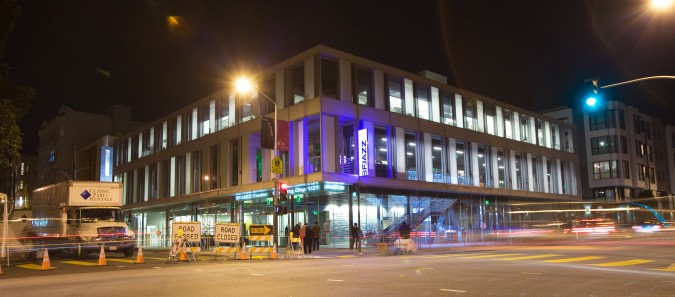
SFJAZZ Center exterior photographed on opening night, January 21, 2013, San Francisco, California USA. Photograph by Kevin Warnock.
The SFJAZZ Center is an ambitious center to advance jazz music.
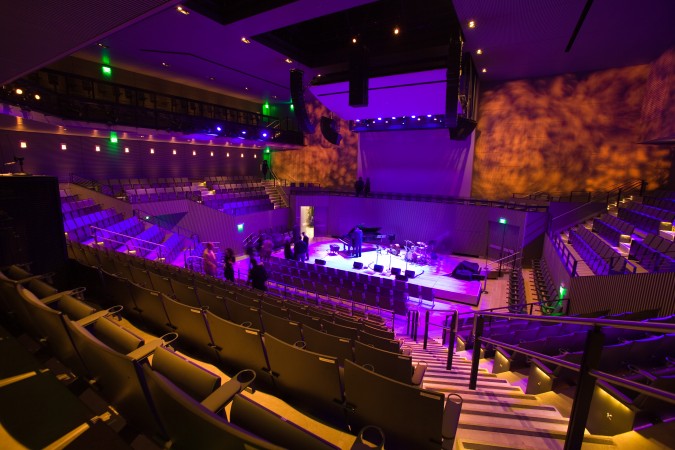
SFJAZZ Center Robert N. Miner Auditorium on opening night, under theatrical lighting, January 21, 2013, San Francisco, California USA. Photograph by Kevin Warnock.
I think the corner of Franklin Street and Fell Street is an outstanding location for the Center — it’s in the trendy and safe Hayes Valley neighborhood, and it’s just two blocks from the Van Ness MUNI station and Market Street.
There was a ribbon cutting ceremony in the morning, which I missed.
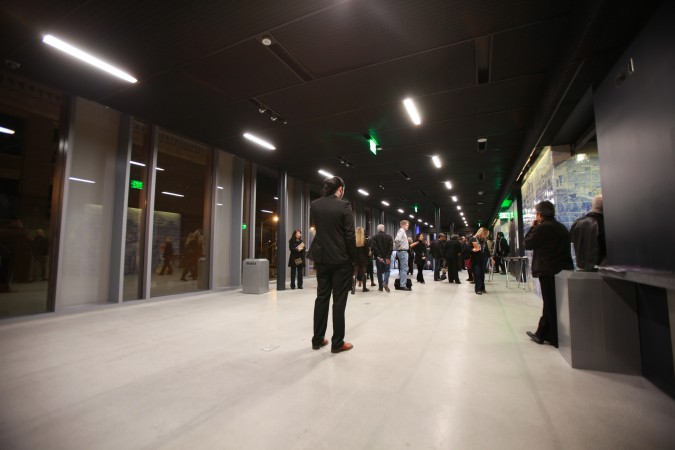
SFJAZZ Center second floor reception area on opening night, January 21, 2013. Photograph by Kevin Warnock.
I went to one of the official tours, in the evening. Attendees got to roam around the facility and admire the building, constructed in 2011 and 2012 to be the new dedicated home for SFJAZZ.
The formal part of the evening featured prepared remarks by Randall Kline, the Executive Artistic Director and Founder of SFJAZZ.
Rebeca Mauleón, the Director of Education, also spoke.
The SFJAZZ High School All-Stars performed in the large music hall, named the Robert N. Miner Auditorium, which features steeply set seats designed to allow the musicians to see the faces of the audience members. This Auditorium also features a glass wall that looks out onto the busy street, which will drum up interest in the performances because passersby will be able to catch a glimpse for free as they walk or drive past. I’ve always thought it is good marketing for martial arts studios and dance studios to have large glass windows at street level. SFJAZZ Center is taking a page out of their public relations book, and I predict good things will happen as a result of doing so.
I was exceptionally impressed with the High School All-Stars. I introduced myself to the members and invited them to read my blog.
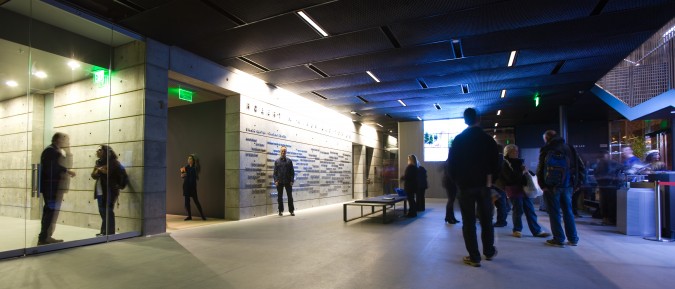
SFJAZZ Center, ground floor reception area, on opening night, January 21, 2013. Photographer and blogger Kevin Warnock is standing by the donor names on the wall.
I was given a lushly produced magazine/program for SFJAZZ during the tour this evening. SFJAZZ Founder Randall Kline had this to say, on page 7:
Welcome to the first season
After 30 years of presenting music in a variety of rented venues throughout the Bay, it is with great joy we begin our first season in our new home, the SFJAZZ Center. It is the first freestanding building for jazz in the country — designed, from concept to concert hall, to create an enhanced setting for experiencing what the esteemed jazz write Whitney Balliett calls “the sound of surprise.”
The SFJAZZ Center is home for all that we do: concerts, education programs for adults and youth, our award-winning SFJAZZ High School All-Star Ensembles, the world-renowned SFJAZZ Collective, and the new SFJAZZ Monday Night Community Band.
Over our three decades, SFJAZZ has grown to become a vital part of the cultural fabric of San Francisco. And in the broader context of the jazz, we have been recognized as one of the top presenters in the world — helping to place San Francisco, with its rich jazz history, among the vanguard of cities where this American-born art form can be best heard.
Kline continued his remarks — I have not typed all of them here — and concluded with:
Jazz has a home in San Francisco. The first season begins. See you at the Center!
Sincerely,
Randall Kline
Executive Artistic Director and Founder
The new Center shows a lot of promise. I am intrigued, so I plan to return soon to the Center to see a show.
I took the pictures that accompany this post with my Canon 5D Mark II camera. I uploaded these images at full resolution of 21 megapixels. Click on them to see the full size versions.
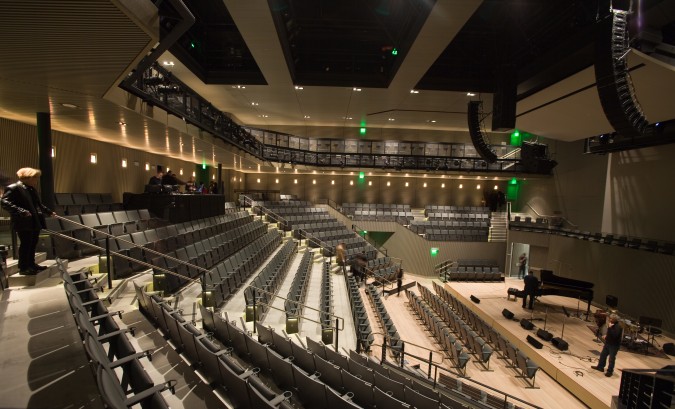
SFJAZZ Center Robert N. Miner Auditorium in neutral, bright light on opening night, January 21, 2013. Photograph by Kevin Warnock.
Today was a busy day in the United States of America.
- The country celebrated the birthday of Martin Luther King, Jr. with a federal holiday.
- It was inauguration day for US President Barack Obama, who began his second term yesterday.
- The SFJAZZ Center officially opened its doors.
Outstanding.
[Edit on January 23, 2013 — I added two names to the caption of the group photo of the All-Stars, above, once I got the correct spellings.]
